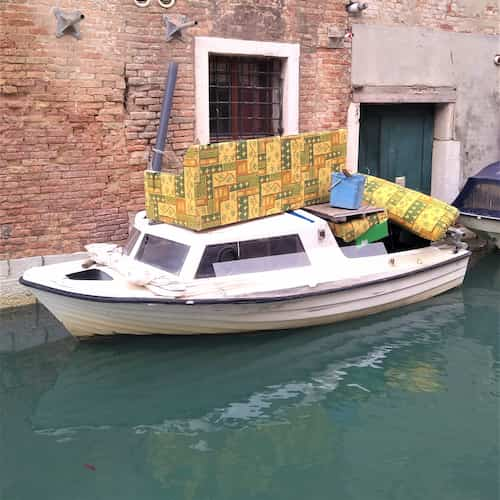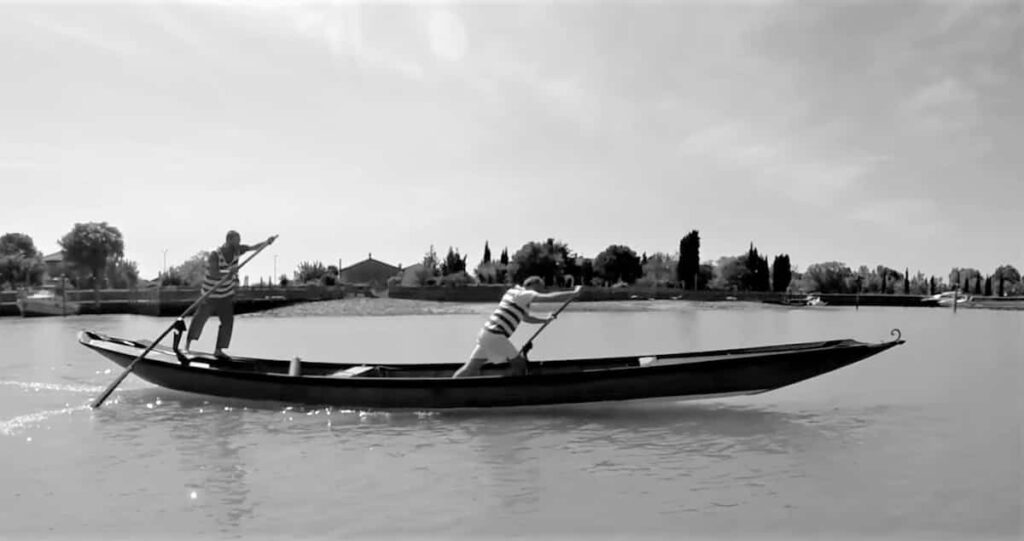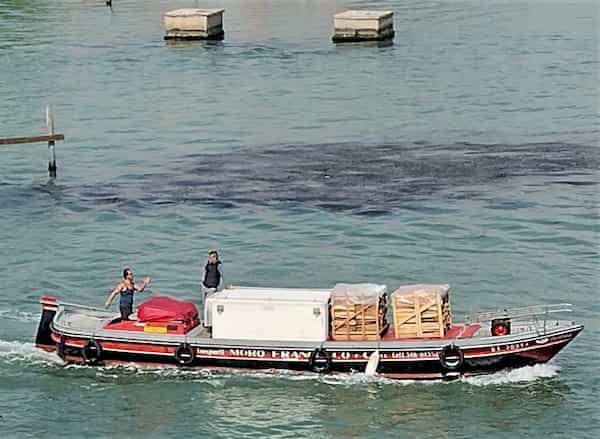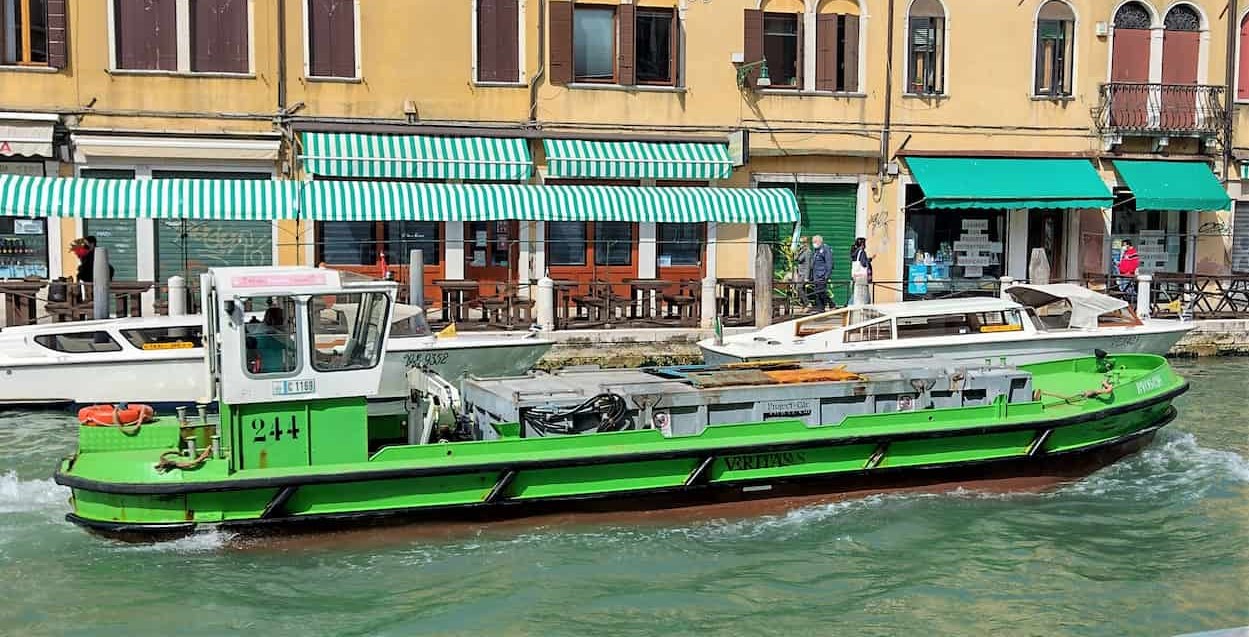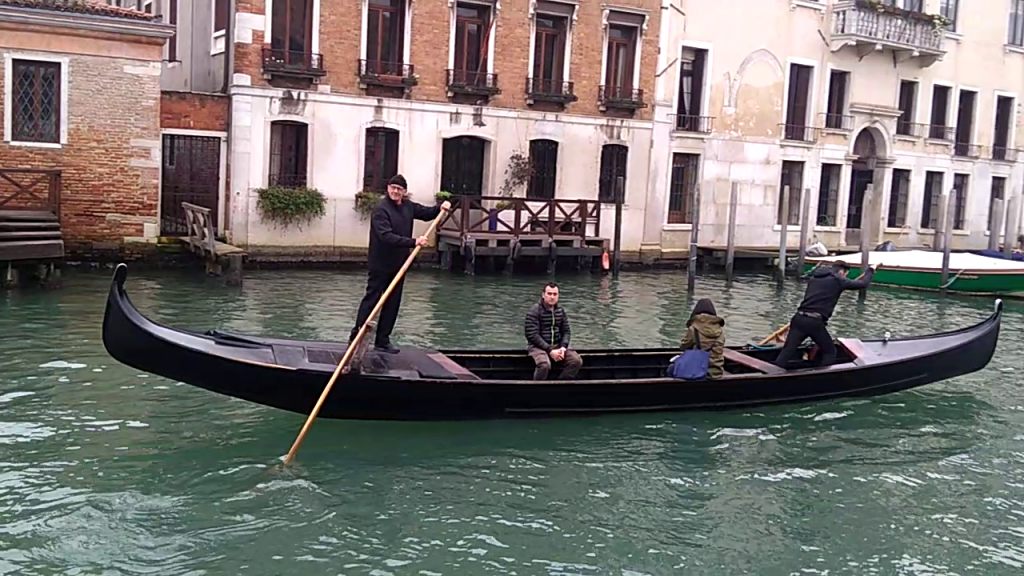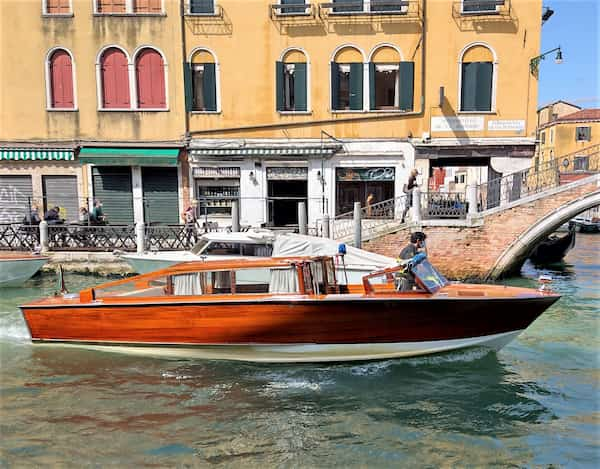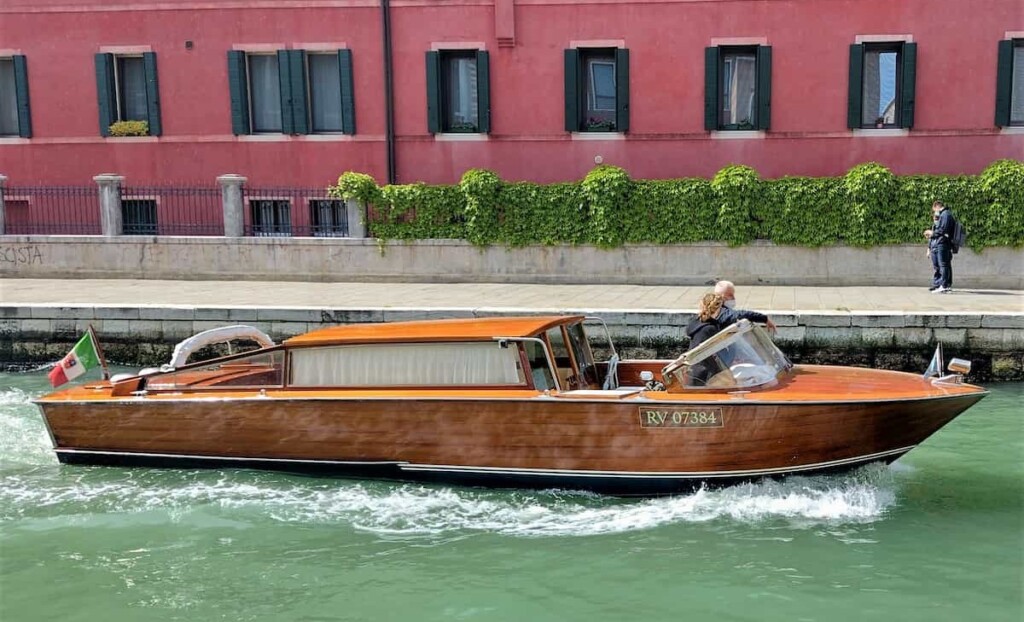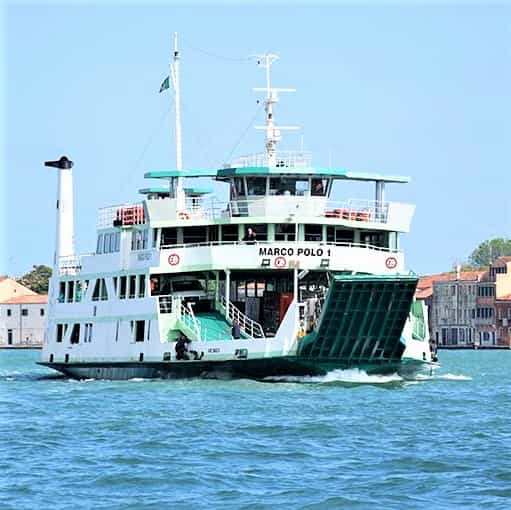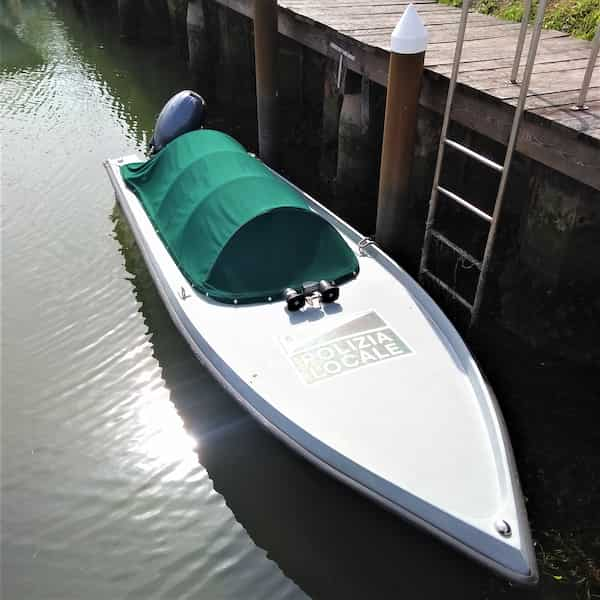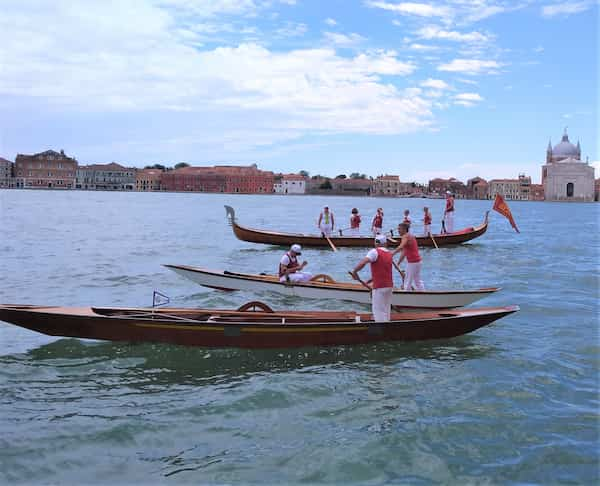Looking out on Grand Canal on any normal day, you see a variety of floating vessels. The boats in Venice are many, and Canal Grande is the main exhibition of all the different types you can find in the lagoon city. They are long, short, big, small, with a motor, or with single or double oars. The intense traffic would correspond to the Boulevard or central avenue of any other, dryer city.
The tourists ride the Vaporetto, they go by Taxi or by Gondola… But there is quite a lot of necessary service traffic too, mostly cargo boats. Then there are post boats, police boats, other law enforcement watercraft, ambulances, and the boats of the firefighters. And of course, there are a whole lot of private boats. Venice is a well-functioning city and just like any other urban area, it needs transport of goods and people in every possible way.
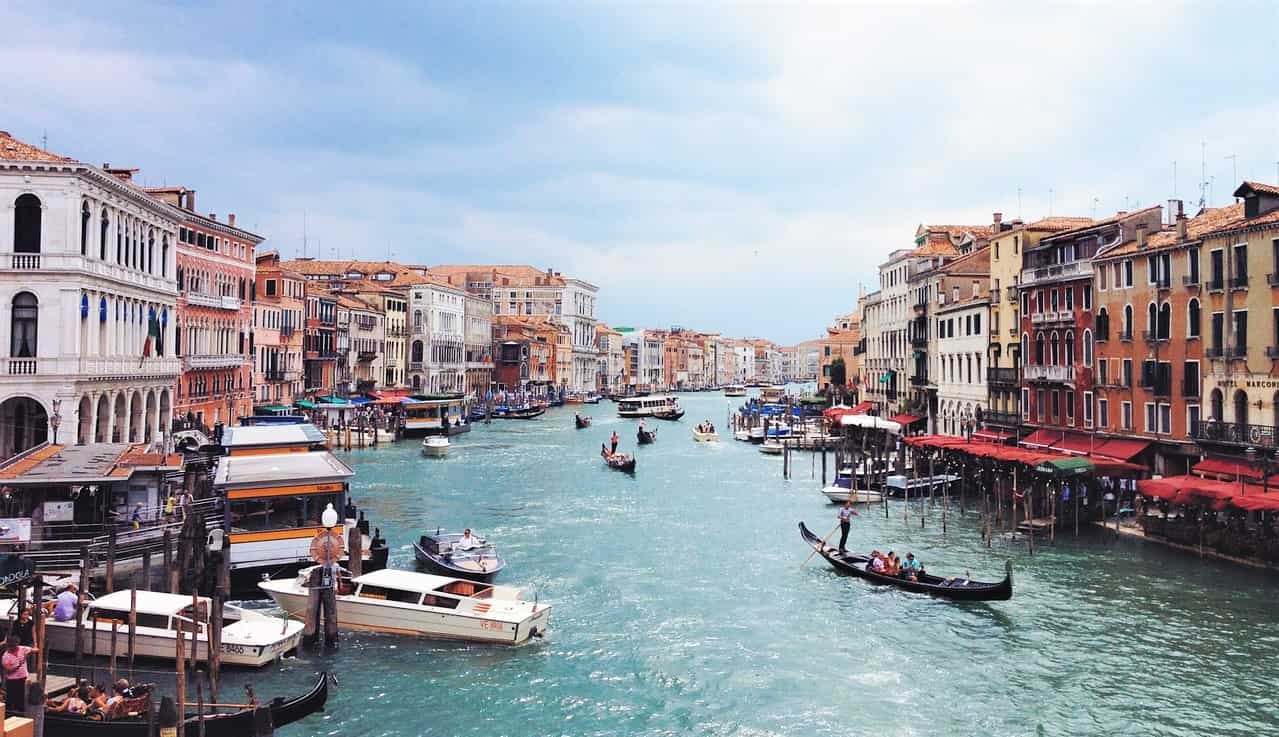 If you’d like to bring your own boat and go for a nice morning drive on the big canal, you can forget it, unless you live here. And even then there are long lists of boat regulations, speed limits, one-way canals, and traffic rules you need to adhere to.
If you’d like to bring your own boat and go for a nice morning drive on the big canal, you can forget it, unless you live here. And even then there are long lists of boat regulations, speed limits, one-way canals, and traffic rules you need to adhere to.
Driving a boat on Grand Canal is reserved for Venice City residents. And only after 12 o’clock. To use a boat with a motor, you would need a license issued by the same city. The speed limit on Canal Grande is 8 km/h (4 knots) and on the smaller canals 5 km/h (2,5 knots).
But this wasn’t meant to be a guide on how to drive a boat on the Grand Canal. What I wanted to do was just to explain the various types of vessels, you would see when looking down on the water from one of the bridges.
And as a list of the boats can be done in various ways, and as the most common way is to include all the traditional, historical boats of the lagoon… I will do it in a more contemporary, modern way. So, here’s a list and an explanation of the watercraft you are likely to see on a perfectly normal day in Venice. It is in no way complete, as many of the traditional boats have more or less disappeared from the lagoon. Some old vessels have evolved and now live on in modern versions.
All these boats are made of wood, if not described otherwise.
What are the boats in Venice called?
Gondola
The Gondola is the most famous of them all, the symbol of Venice and the definite King of the Venetian waters. You see them all over with tourists eagerly inhaling the beauty of the city while the Gondoliere explains the sites in broken English. A few hundred years ago, they were even more frequent, as the Gondola in the past was in Venice what a horse-cart was in London… The normal way of transport within the city. At least for anyone with money. Here’s a complete Gondola guide.
Sandolo
The Sandolo is one of many very similar boats in the Lagoon… Boats of which a branch with the passing centuries developed into the Gondola. They were all small, narrow, and long. And propulsion was a single oar on the starboard side towards the stern of the boat.
The name Sandolo obviously shares the same root as Sandal, the footwear. Sandalium, Latin for shoe, reflects the flat bottom of the boat. Like most vessels in the lagoon, one of the most important features was the capability to move when the water is low or very low… Thus the flat bottom.
It’s not always easy to distinguish what is a Sandolo and what is not. The boat type is so common, and with so many variations that distinguish it can be problematic. Especially when we look back on history. Almost all of the small boats are somewhat similar to the Sandolo.
The boat types that have survived until modern times are divided into subcategories, such as:
- Pupparino. 2 oarsmen. A very long (10m), narrow, and graceful Sandolo. Today they are used in regattas, as they are very fast.
- Sandolo s’ciopon. 1 oarsman with double oars. The samllest of the Sandolos. So light and flat that it can enter where other boats cannot. Used mainly for hunting in the marshlands. The name means burst as in rifle burst (Scoppio [skɔpiɔ] in Italian, S’ciopo [sʧɔpɔ in Venetian).
- Sampierotto, Sandolo Buranello, and others are all fishing boats. 1-2 oarsmen They are simple but often a few centimeters wider and with a greater load capacity.
- Mascareta. 2 oarsmen. 6 to 8 meters in length and very light, low, and fast. Nowadays and almost exclusively used in Regattas.
- Sandolo da barcarole. 1 oarsman. This is the one you will likely first come across. It is used to scam tourists into thinking they’re going for a Gondola ride when actually they’re riding another boat. It might be equally pleasant, but it’s not a Gondola.
- … And many others.
Batela Buranela / Batela Coa de Gambero
The word, Batela, means just boat in Venetian. But the term comes with a baggage of history and tradition. The Batela is a wide wooden boat for transport and work. Normally rowed with two or four opposite oars. In the past, the Batela was the most commonly used of all the cargo boats in Venice. You could see them all over running back and forth with all kinds of merchandise. Now they are mostly substituted with motorized Topi.
It is bigger than the Sandolo, up to 12 meters in length, with higher bords, but still kind of narrow and slender. It’s powered with manpower, so the resistance has to be small. Oars can’t do wide vessels.
Two versions exist, Batela coda di Gambero (Coa de Gambaro), and Batela Buranela (which obviously originates from Burano). The latter is wider and more of a transporter. Apart from that, the Batela coda di Gambero has a flat stern, while the Buranela has a pointed, elevated stern. This makes it easier to row but lowers the cargo capacity.
Rowvenice.org uses the Batela coda di Gambero for their lessons in Voga Veneta.
Topo/Mototopo
When the modern Diesel engine entered Venetian everyday life, the Mototopo became the typical Venetian transport vessel. You see these motorized topos all over with the transporting company logo on the side. They bring food and beverages to the hotels and packages and other stuff to offices and private houses.
Topo means mouse, and before the mouse was equipped with an engine, they were equipped with other thrusters. The everpresent oars, but also sails. In the old days, the Topo was a versatile companion for transporting heavy goods out on the open lagoon and even out on the sea. The rounder boards with a less squared floor and the greater width for and aft made them much safer in open waters with stronger winds.
As with all the other boats, there are many variations, battello a pìsso, musséto, batèlo col fìlo. One recent development is the Topa (… as in a female mouse.). What happened was simply that they cut off the pointed stern and made it flat. In that way, you can put a small outboard engine there, and so it becomes a popular and simple transport vessel for private use.
All transporting of things with boats in Venice is regulated and controlled. You are actually not allowed to bring your own refrigerator home, the transporting consortium has the monopoly.
The modern Mototopos come in many forms and sizes, with a cabin or without. They can be as long as 14 meters, and as small as 6. They have a large beam and are incredibly stable. At the beginning of 1900, the heavy marine diesel came on board. That forced the already wide stern to become even wider, and the buoyance to increase further. The result was a vessel that is as stable as a lorry on dry land. That makes them very practical when it comes to loading and unloading directly on the Fondamenta.
Garbage boat
These are highly specialized ships, made in steel, or recently in fiberglass. Around 12 meters in length and with a net cargo capacity of 10 tonnes. The waste bins are picked up from the key with a crane mounted on the boat. If the vessel is equipped with a compactor, the waste is then compressed on board before it is transported to the recycling center.
The City of Venice has a total of 60 of them. Not all of them are in Venice. Many are in service around the other islands, Murano, Burano, Lido, etc. But they are quite common in Venice in the canals of medium size. All are colored in a light green hue, which makes them easily distinguishable.
Of the 60 vessels, 44 are powered by Stage V engines. Stage V is the latest stage of the European emission standards for Non-road engines. They are all from 2016 or later. Venice actually makes a great deal of effort to reduce the environmental impact of its service fleet. As another important step in that direction, two new electric/hybrid ships have been purchased and are now operational.
Caorlina
This is another traditional wooden boat nowadays used mainly for racing, especially in traditional rowing competitions, like Vogalonga and Regata Storica.
The name comes from the city of Caorle to the northeast of Venice, once an important and prosperous part of the Republic. The boat was once something of the standard fishing, and transport vessel in those parts, much like the Batela was in Venice. It could be well over 10 meters back then, but now they are smaller and less wide, to gain speed.
Because just like many other traditional Venetian boats, today they are used solely in regattas. In ancient times they were rowed with one or two oarsmen, but as it has become a race boat, nowadays it has 6 oars.
An interesting fact is that it is symmetric. The stern and the bow are identical, pointed, and bent upwards.
Barcheta a massoche
A bigger Gondola that can take up to 14 persons plus the two Gondoliers. It is made in the same manner as a normal Gondola, but it’s wider, more stable, and has a higher gross load capacity. It’s used for the Traghetto… The short ride from one side of Canal Grande to the other.
The rowing technique is somewhat different, as you push on both sides. It is only the Gondolier at the stern that steers. The one at the bow is just pushing. Landing perfectly at the pier takes a little maneuvering back and forth, and that’s when both Gondoliers have to collaborate. Sometimes the collaboration can be audible.
Police / Ambulance
The Ambulances and the Police-boats are the only Venice boats that are allowed to exceed the speed limits. When there’s an emergency they can reach incredible speeds leaving other boats behind, all trying to stay afloat in the wakes.
The top speed is up to 35 knots or 40 Miles/h.
Taxi
The various Venice taxis come in wood, in wood/fiberglass, or fiberglass exclusively. The curious fact about the taxis is that, although they come from various shipyards, and there are both old boats and brand new ones, they are all exceptionally similar. The driver’s seat, behind which there’s the cabin. And at the back, there’s an open space for photo sessions and sunbathing. And the shape and size are almost identical.
But it wasn’t always like that. The taxi era started in the late 1800s. At that time they could be different in shape and size. Then came the first motor taxis. They all had a petrol engine mounted in the bow. When petrol got too expensive, they started using diesel engines. These were so heavy that the boats couldn’t maintain the horizontal waterline with the engine in the bow. They had to be put in the stern.
But by doing so the taxis became stern heavy. And the disproportional weight distribution combined with the total mass of the engine, suddenly made the wakes dangerously large. And the whole controversy of the motor-driven boats in Venice that drained material from the delicate canal sides, and thus risked a complete collapse o the whole Venice foundation, started.
Nowadays that problem is not solved, but it is less evident. The taxis are wider with better buoyancy at the stern, and the engines weigh less. With added speed limits and regulated access to the canals, the high wake issues have disappeared from the newspaper’s front pages. Not everybody agrees with me on that one though…
Vaporetto
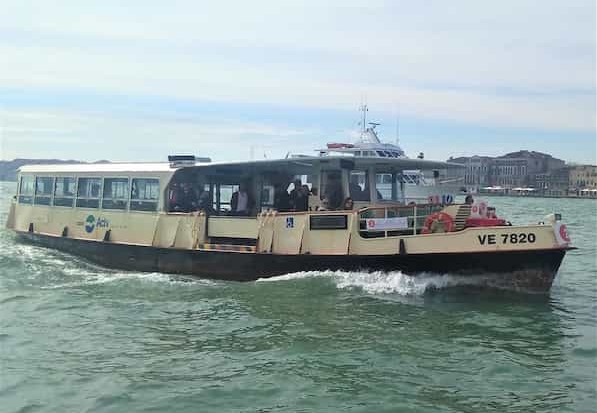
The Vaporettos is the water buss, bringing people from east to west, from north to south. Made in metal with the typical entrance and exit midships (…If you could invent a system where people could enter and exit from different gates, but still with only one sailor handling the crowds, you would make a fortune.).They are mostly around 20 meters in length, but ACTV, the local public transport company, has many different kinds of Vaporettos.
The classical water bus, line 90, is the only one running the Canal Grande. Outside, circumnavigating the City, there are the smaller vessels, we call them Motoscafi… Which is just another name for a motorboat. Then there are bigger ones crossing the lagoon to Lido, Punta Sabbioni, and Burano.
And why are they called Vaporetto?
Vapore means steam, and although all Vaporettos are equipped with diesel engines, the name has remained from when they were all driven by steam. The very first line opened already in 1857 bringing people from Venice to Chioggia, and vice versa. And they continued to bring things and folks from here to there inside the city and towards the other islands as well as the mainland. The steam engines were weak in power but easy to maintain as the mechanics of the engine were quite simple and straightforward.
Not until after the second world war, the steam engines were finally sent to the scrapyard. And new modern diesel engines took over. The name remained though. Like so much in Venice, the people like to maintain the old names and traditions, even when they are outdated. That’s just the way we are.
Ferry Boat
The biggest of ACTV’s ships and the only car-carrier is the big Ferry from Venice to Lido di Venezia. There are a few different models. The biggest one takes 1250 passengers and 71 cars. It’s driven by two Caterpillar diesel engines each of 740 hp.
They depart from Tronchetto ( The first island on your right before you arrive at Piazzale Roma over the bridge from the mainland.), and they arrive at San Nicolò a kilometer to the northeast of the center at Lido.
The trip is very nice as it cruises along all of Canale della Giudecca. The shoreline of both Venice and Giudecca can be enjoyed from the sun deck. Take notice of the many extremely leaning belltowers while passing.
Cofano
Sometimes you see a very small outboard motorboat with a teenager and his friend or girlfriend… Sometimes accompanied by the rhythmic bass drum of the latest song by the latest rockstar.
The boat has very low boards, and it’s narrow. That’s a Cofano. It’s a vessel for hunting and fishing in the shallow waters of the lagoon, as well as for fooling around in the canals, as teenagers do. It’s one of the most common of all the boats in Venice.
Bucintoro
It’s not something you would be able to see. Still, it was a sensational boat, full of the most precious materials, gold, jewels, and silk. It was the ceremonial boat that was used at the wedding ceremony between the Republic and the sea, celebrated the day of the Ascension of Jesus. The last original boat was destroyed and stripped of its gold by the French after the fall of the Republic in 1797. A project to reconstruct her was started in 2004. Unfortunately, because of lacking funds, it’s put on ice.
The boats in Venice come in multiple various shapes, and forms, more or less traditional, as well as new and old boats that don’t have anything to do with the history of the lagoon. But Venice is and has always been a maritime hub. It has always attracted watercraft from near and far.
And the craftsmanship of the Venetian boat builders was what made Venice, Venice. From the small boats, specialized to bring people and goods on the narrow canals, to the huge ships sailing out from the Arsenale to defend the Venetian trading routes.
In June, the Venice Boat-Show continues to demonstrate the importance of boat building in the lagoon city.
